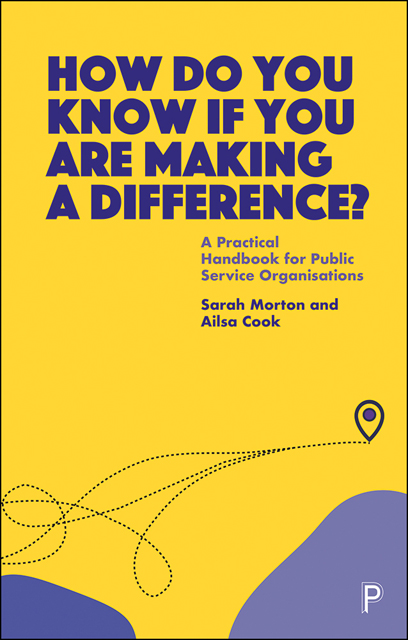 How Do You Know If You Are Making a Difference?
How Do You Know If You Are Making a Difference? Book contents
- Frontmatter
- Dedication
- Contents
- List of figures and tables
- Acknowledgements
- Preface
- 1 Why is it so hard to know if you are making a difference?
- 2 Why complexity thinking can help you understand public services
- 3 What data and evidence do you need to see what difference you are making?
- 4 Embrace the complex contex
- 5 Embrace the complex context
- 6 Clarify the change you want to see
- 7 Get going on your data, evidence and feedback improvement journey
- 8 Tracking progress towards outcomes and impacts
- 9 Telling the story of the difference your work makes
- 10 Using this approach in different contexts and sectors
- 11 Becoming an outcome- and impact-focused organisation
- References
- Index
6 - Clarify the change you want to see
Published online by Cambridge University Press: 20 June 2023
- Frontmatter
- Dedication
- Contents
- List of figures and tables
- Acknowledgements
- Preface
- 1 Why is it so hard to know if you are making a difference?
- 2 Why complexity thinking can help you understand public services
- 3 What data and evidence do you need to see what difference you are making?
- 4 Embrace the complex contex
- 5 Embrace the complex context
- 6 Clarify the change you want to see
- 7 Get going on your data, evidence and feedback improvement journey
- 8 Tracking progress towards outcomes and impacts
- 9 Telling the story of the difference your work makes
- 10 Using this approach in different contexts and sectors
- 11 Becoming an outcome- and impact-focused organisation
- References
- Index
Summary
Working with initiatives that are trying to tackle some of the most difficult problems society faces can be challenging. As we have already discussed, when working with people – whether empowering, educating, inspiring, supporting or collaborating with them – initiatives often have a sense of what they are trying to do, and sometimes one or more outcome they are working towards. These outcomes might come from funders, the organisational mission, the Sustainable Development Goals or national frameworks, and, as we said in Chapter 4, it is easy to get caught in a tangle of outcomes.
While goals and outcomes can usefully give a sense of direction and the bigger picture, what is often missing is clarity of how what is being d elivered might contribute to the outcomes or impacts that matter.
A meaningful connection between activities and outcomes is often vague or unexplored – but this magic ‘how’ change happens is essential for driving programmes and for understanding their impact.
Outcome or impact maps are the core of the approach in this book, as the building block for setting out, understanding, learning about and evidencing change. This is one type of ‘theory of change’ approach which is common for understanding change in complex systems. We believe that process- driven theories of change are most effective for public services, and in this chapter we set out our version of this – outcome or impact mapping – and illustrate how it can be used at different levels.
This chapter discusses:
• thinking about whether and how something makes a difference: an introduction to theories of change and outcome mapping;
• the key components of an outcome or impact maps;
• what is different about this approach;
• the role of pathways in understanding change;
• outcome mapping at different levels: project, programme, organisation or partnership;
• bringing an outcome or impact map to life with risks and assumptions.
This chapter builds on the concepts introduced earlier in this book – especially Chapter 4 on working with outcomes and clarifying your contribution – but also with the challenge of making services more fit for the complex world of delivery. We hope this chapter will give you a very practical way of developing a vision for the change you are working towards and opening up how you think that change will happen.
Information
- Type
- Chapter
- Information
- How Do You Know If You Are Making a Difference?A Practical Handbook for Public Service Organisations, pp. 76 - 100Publisher: Bristol University PressPrint publication year: 2022